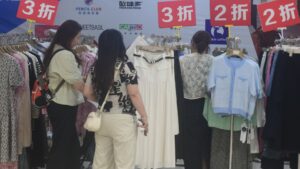Understanding the Current State of Consumer Spending in China: Insights from Extreme Investor Network
As we dive deeper into the consumer landscape in China, it’s clear we are witnessing a period of significant transformation. Recent trends indicate that the vibrancy of consumer spending is facing serious challenges, primarily due to stagnant income growth and shifting preferences. Here, at Extreme Investor Network, we aim to bring you comprehensive insights that are not just informative, but strategically actionable for anyone looking to navigate the complexities of investing in this dynamic economy.
Current Trends: A Stagnant Consumer Landscape
China’s consumer spending has shown little sign of revival, maintaining a bleak trajectory over the past several months. With four consecutive months of declining consumer prices and consumer confidence languishing near historic lows, the outlook appears grim. According to Jeremy Stevens, an Asia economist at Standard Bank, the average growth rate of disposable income has halved since the pandemic, now resting at only 5% annually.
Most sectors have been unable to offer meaningful wage increases, with only mining, utilities, and IT services experiencing growth that outpaces GDP since 2020. The overall unemployment rate hovers around 5%, but youth employment reflects sobering statistics: 15.8% among those aged 16-24 remain jobless as of April. And as we analyze these numbers, it becomes evident that the consumer mindset is more cautious than ever.
The Saving Mentality: A Cultural Context
The cultural backdrop is pivotal in understanding China’s consumer sentiments. In a recent PBOC survey, a striking 64% of households indicated a preference for saving over spending or investing. This figure only marginally improved to 61.4% by the end of 2024, revealing a persistent inclination toward preserving wealth rather than consuming it.
This saving behavior isn’t just a trend; it’s a deeply ingrained cultural habit, exacerbated by a limited social safety net. Many Chinese individuals bear significant personal costs in healthcare, education, and retirement. With real estate values—typically a primary source of household wealth—under duress, the reluctance to spend is amplified.
Emerging Strategies for Increased Spending
While challenges abound, some policymakers are contemplating ways to rejuvenate consumer spending. Economic analysts like Luo Zhiheng advocate for substantial changes, including doubling pension payouts and expanding public holiday offerings alongside consumption vouchers for the service sector. These initiatives aim to give consumers the financial breathing room they need to re-engage with the market.
However, unlike the mass cash handouts seen in the U.S. and Hong Kong, China has opted for more tailored support measures. The approach reflects a strategic understanding of the need for targeted economic stimulation while avoiding the pitfalls of inflation that can come from blanket financial incentives.
The Shift Towards Tier One and Tier Two Cities
Revisiting the dynamics of urban versus rural consumption reveals that many households are opting for lower-priced goods, a move influenced both by economic constraints and a migration trend from upper-tier cities to more affordable locales. Notably, places categorized as "tier 3" and "tier 4" cities experienced increased economic activity as consumers seek value for their money.
This shift has resulted in an uptick in daily necessities sold while averaging consumable prices have dipped as consumers gravitate towards budget-friendly options. For instance, as observed in the Kunming International Flora Auction, the demand for flowers has surged in lower-tier cities, yet prices are falling as production increases.
A New Consumer Rationality
There is a palpable shift in the mindset of Chinese consumers post-pandemic. Bruno Lannes from Bain observes that consumers are now more discerning, prioritizing value and necessity over brand loyalty. This indicates a tilt towards rational spending; consumers are no longer just going for the latest trends but are deeply considering the return on every dollar spent.
As China prepares to release retail sales data for May, analysts anticipate a slowdown to 4.9% year-on-year, down slightly from 5.1% in April. This prediction reinforces the need for businesses and investors to recalibrate their strategies.
Conclusion: Navigating the New Normal
In summary, the current state of consumer spending in China is indicative of broader socio-economic currents influencing behavior. The slow recovery of retail sales, the cultural inclination towards saving, and the migration patterns are critical factors shaping the landscape.
As we at Extreme Investor Network embark on this journey of understanding and navigating investment opportunities in this evolving market, it’s essential to keep abreast of these trends. By utilizing strategic insights and understanding consumer sentiments, investors can position themselves advantageously for the future. Stay informed, stay ahead — your investment journey awaits!

